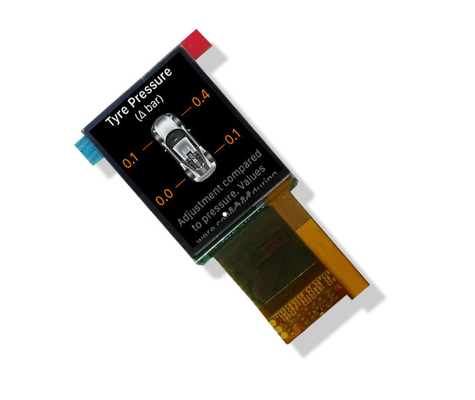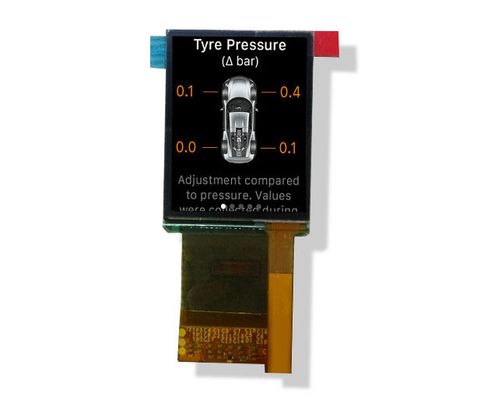-
Affichage d'affichage à cristaux liquides TFT
-
Affichage de TFT d'écran tactile
-
Affichage rond de TFT
-
ecran couleur de tft
-
module amoled d'affichage
-
Micro OLED Affichage
-
Type TFT de barre
-
Affichage TFT carré
-
Affichage d'affichage à cristaux liquides d'intense luminosité
-
Affichage LCD COB
-
Lumière du soleil TFT lisible
-
Affichage d'UART TFT
-
Module d'affichage d'affichage à cristaux liquides
-
Affichage de PMOLED
-
affichage d'epaper
-
Affichage numérique de LED
-
Écran tactile capacitif
Module d'écran LCD AMOLED de 1,45 pouces avec fonction tactile, luminosité 350, résolution 272x340, interface MIPI, 24 broches
| Lieu d'origine | Chine |
|---|---|
| Nom de marque | ESHX |
| Certification | ISO14001/ ISO9001/IATF16949 |
| Numéro de modèle | Le nombre d'équipements utilisés est déterminé en fonction de l'échantillon. |
| Quantité de commande min | 1000 |
| Prix | Négociable |
| Détails d'emballage | Blister + boîte en mousse + sac à bulles + carton intérieur + carton principal |
| Délai de livraison | 6 à 8 semaines |
| Conditions de paiement | T/T |
| Capacité d'approvisionnement | 50K par mois |

Contactez-moi pour des aperçus gratuits et des bons.
WhatsApp:0086 18588475571
wechat: 0086 18588475571
Skype: sales10@aixton.com
Si vous avez n'importe quel souci, nous fournissons l'aide en ligne de 24 heures.
x| Technologie d'affichage | Module d'affichage AMOLED | Nom | Panneau d'OLED |
|---|---|---|---|
| Taille | 1.45 pouces | Résolution de l'écran | 270*340 |
| Lumière | 350cd/m2 | Zones visibles | 23.01*28.77 (mm) |
| Garantie | Garantie de qualité d' un an pour le service après-vente | ||
| Mettre en évidence | Module d'écran LCD AMOLED de 1,45 pouces,Module d'écran LCD AMOLED 272x340 |
||
Écran LCD AMOLED de 1,45 pouces avec une luminosité de 350, une résolution de 272x340, 24 broches, une interface MIPI, un module d'affichage de petite taille avec fonctionnalité tactile
A : Paramètre du produit
![]()
B : Image du produit
![]()
![]()
C : Schéma et définition des broches
![]()
D : Connaissance des produits OLED
Avantages de l'OLED :
Les écrans OLED sont plus légers et plus fins que les LCD, avec un contraste élevé, une saturation des couleurs élevée et une consommation plus faible
Inconvénients de l'OLED
L'AMOLED est extrêmement cher par rapport aux LCD et TFT, et sa durée de vie est plus courte que celle des LCD et TFT
E : Informations sur l'entreprise
Avantage Huaxin :
1. Base d'usine située dans une ville de l'intérieur des terres, ce qui est rentable
2. Équipement neuf le plus avancé qui peut maintenir une qualité stable
3. La plupart des processus utilisant un équipement entièrement automatique, ce qui assure l'efficacité et une qualité stable
4. Ingénieurs et responsables de production professionnels qui travaillent dans le domaine des LCD depuis plus de 20 ans
5. Conception propre pour un produit personnalisé
Nos certificats
1.ISO14001/
2.ISO9001/IATF16949
3.SGS du module LCD
- Huaxin Technology (Enshi)Co.,LTD
- Hubei.Enshi
- Date de fondation : 2009
- Entreprise de haute technologie travaillant principalement sur la recherche et le développement, la production et la vente de LCD, LCM, TFT, rétroéclairage, OLED
- Les LCD comprennent : VA, TN, HTN, STN, FSTN, CSTN et autres séries
- Les LCM comprennent : COB, TBA, COG, TP, rétroéclairage LED et autres séries
- Capital social : vingt millions
- Personnel actuel : 500+
- RD représente 10 %
- QC représente 15 %
F : Capacité de production
| Production annuelle Capacité |
2021 (Actuel) | 2022 (Objectif) | 2023 (Défi) | 2024 (Défi) | 2025 (Défi) | Remarque | ||
| Production de LCD Capacité |
4.5 | 9 | 9 | 9 | 9 | Unité : milliers de logarithmes/jour |
||
| Production de LCM Capacité |
70 | 150 | 300 | 450 | 450 | Unité : Mille pièce/jour |
||
| Production de rétroéclairage Capacité |
100 | 200 | 300 | 500 | 500 | Unité : Mille pièce/jour |
||
| Production d'OLED Capacité |
10 | 20 | 30 | 40 | 50 | Unité : Mille pièce/jour |
||
G : Application du produit
1. Coffre-fort et instrument
2. Serrure et maison intelligente
3. Émetteur et montre
4. Montre et radio
5. Collimateur et navigateur
H : Caractéristiques d'affichage AMOLED
1. Pixels auto-émissifs :
2. Rapport de contraste :
3. Précision et vivacité des couleurs :
4. Angles de vision :
5. Efficacité énergétique :
6. Finesse et flexibilité :
7. Temps de réponse :
I : Comment l'efficacité énergétique des écrans AMOLED se compare-t-elle à d'autres technologies d'affichage ?
1. Consommation d'énergie :
- Les écrans AMOLED consomment de l'énergie par pixel, ce qui signifie que les pixels qui affichent du contenu noir ou sombre consomment très peu d'énergie, tandis que les pixels qui affichent du contenu clair ou blanc consomment plus d'énergie.
- Les écrans LCD et LED, en revanche, nécessitent un rétroéclairage constant qui consomme de l'énergie quel que soit le contenu affiché.
2. Dépendance au contenu :
- Les écrans AMOLED sont plus écoénergétiques pour le contenu avec beaucoup de zones sombres ou noires, car les pixels individuels peuvent être désactivés pour économiser de l'énergie.
- Les écrans LCD et LED consomment une quantité d'énergie relativement constante quel que soit le contenu affiché, car le rétroéclairage reste actif.
3. Contrôle de la luminosité :
- Les écrans AMOLED peuvent ajuster dynamiquement la luminosité des pixels individuels, ce qui permet une meilleure efficacité énergétique dans les scénarios de faible luminosité.
- Les écrans LCD et LED ont généralement une luminosité de rétroéclairage fixe, ce qui peut entraîner une consommation d'énergie plus élevée même lorsque le contenu de l'écran ne nécessite pas une luminosité maximale
4. Taille de l'écran
- Les écrans AMOLED ont tendance à être plus écoénergétiques pour les écrans de petite taille, car la consommation d'énergie évolue avec le nombre de pixels.
- Les écrans LCD et LED plus grands peuvent nécessiter des rétroéclairages plus gourmands en énergie, ce qui pourrait réduire leur efficacité énergétique par rapport aux écrans AMOLED de même taille.






